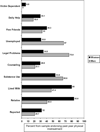Do incident and perpetrator characteristics of elder mistreatment differ by gender of the victim? Results from the National Elder Mistreatment Study
- PMID: 21253929
- PMCID: PMC4017657
- DOI: 10.1080/08946566.2011.534707
Do incident and perpetrator characteristics of elder mistreatment differ by gender of the victim? Results from the National Elder Mistreatment Study
Abstract
Perpetrator and incident characteristics were studied in regard to incidents of emotional, physical, and sexual mistreatment of older adults (age 60+) in a national sample of older men and women. Random digit dialing across geographic strata was used to compile a nationally representative sample; computer assisted telephone interviewing was used to standardize collection of demographic, mistreatment, and perpetrator and incident characteristics data. The final sample size consisted of 5,777 older adults. Approximately one in ten adults reported at least one form of mistreatment, and the majority of incidents were not reported to authorities. Perpetrators of physical mistreatment against men had more "pathological" characteristics compared to perpetrators of physical mistreatment against women. Perpetrators of physical mistreatment (compared to emotional and sexual mistreatment) also evidenced increased likelihood of legal problems, psychological treatment, substance use during incident, living with the victim, and being related to the victim. Implications for future research and social policy are discussed.
Figures



References
-
- Acierno R. Epidemiological assessment methodology. Washington, DC: National Academy of Sciences; 2003.
-
- Biggs S, Manthorpe J, Tinker A, Doyle M, Erens B. Mistreatment of older people in the United Kingdom: findings from the first national prevalence study. Journal of Elder Abuse and Neglect. 2009;21:1–14. - PubMed
-
- Buri H, Daly JM, Hartz AJ, Jogerst GJ. Factors associated with self-reported elder mistreatment in Iowa’s frailest elders. Research on Aging. 2006;28:562–581.
Publication types
MeSH terms
Grants and funding
LinkOut - more resources
Full Text Sources
Medical
